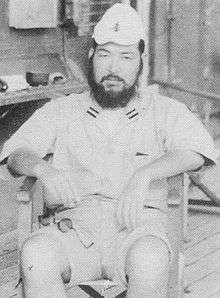Tamotsu Ema
Tamotsu Ema (江間 保, Ema Tamotsu) was a dive bomber pilot in the Imperial Japanese Navy (IJN) during World War II. He led Aichi D3A dive bombers from the carrier Zuikaku during the Battle of the Coral Sea that damaged Yorktown.
Tamotsu Ema | |
|---|---|
 | |
| Allegiance | Empire of Japan |
| Service/ | |
| Unit | Zuikaku |
| Battles/wars | World War II: Attack on Pearl Harbor Indian Ocean Raid Battle of the Coral Sea |
Early career
Tamotsu Ema enrolled in the Imperial Japanese Naval Academy in April 1932 and graduated from 63th class in March 1936. He was eventually selected for pilot training and specialised in dive bombing.
On 7 December 1941, Lieutenant Ema participated in the Attack on Pearl Harbor. He led one of the dive bomber divisions of Zuikaku that bombed and strafed American aircraft and hangars on Wheeler Field.[1]
In April 1942, Lieutenant Ema participated in the Indian Ocean Raid. He led one of the dive bomber divisions of Zuikaku that bombed and sunk British carrier Hermes. Shortly after the battle, he became a senior flight division leader (senior buntaichō) and was given the command of Zuikaku dive bomber squadron.[1]
Coral Sea
In May 1942, Lieutenant Ema participated in Operation MO aboard Zuikaku that resulted in the Battle of the Coral Sea. In the morning on 7 May, he and his squadron were part of the strike against the oiler Neosho and the destroyer Sims (falsely identified as a carrier and a cruiser) that was under overall command of Lieutenant Commander Kakuichi Takahashi. Unable to find any enemy carriers, Takahashi ordered the dive bombers to attack the oiler and the destroyer. After sinking Sims and fatally crippling Neosho, the strike force headed back to their carriers.[2][1]
Meanwhile, the actual USN carrier fleet was spotted and Rear Admiral Chūichi Hara planned to launch an afternoon strike as soon as Takahashi's force returned. However, Lieutenant Ema's 16 D3A dive bombers got lost in a bad weather and returned late. This meant that the new strike would be forced to land at night upon their return. Hara therefore selected only veteran aircrews for this strike, including Lieutenant Ema and five of his pilots. The strike was ill-fated as it missed the USN carriers due to poor weather, and in return lost eight Nakajima B5N torpedo bombers and one D3A to radar-guided interception force of Grumman F4F Wildcat fighters led by Lieutenant Commanders Paul Ramsey and James Flatley.[2][1]
The next morning on 8 May, the two carrier fleets sighted each other. Lieutenant Commander Takahashi led a strike force of 33 Aichi D3A dive bombers, 18 Nakajima B5N torpedo bombers and 18 Mitsubishi A6M Zero fighters. Lieutenant Ema led 14 of Zuikaku's dive bombers. The strike force approached the USN carriers unopposed since USN interceptors missed them due to the poor radar guidance. Takahashi devised and executed a well-coordinated attack, where 19 dive bombers and 14 torpedo bombers went for the nearer Lexington and 14 dive bombers and four torpedo bombers went for the farther Yorktown. Lieutenant Ema led the dive bombing attack on Yorktown, which was hit by a single bomb. Due to high losses of torpedo bombers and their veteran aircrew during the previous night's strike, only four were available for the attack on Yorktown, and they all missed.[3][1]
Later life
Lieutenant Ema survived the war and later published a book that comprises a collection of battle accounts from several IJN dive bomber aircrew, including himself, Sadamu Takahashi, Keiichi Arima and Zenji Abe, among others.[4]
References
- Tagaya 2011.
- Lundstrom 2005a, p. 189-210.
- Lundstrom 2005a, p. 211-282.
- 江間 1991.
- Sources
- 江間, 保 (1991). 急降下爆撃隊―日本海軍のヘルダイバー (in Japanese). 今日の話題社. ISBN 4875651384.
- Lundstrom, John B. (2005a). The First Team: Pacific Naval Air Combat from Pearl Harbor to Midway (New ed.). Annapolis, Maryland: Naval Institute Press. ISBN 1-59114-471-X.
- Tagaya, Osamu (2011). Aichi 99 Kanbaku 'Val' Units. Combat Aircraft #63. Osprey Publishing. ISBN 1841769126.